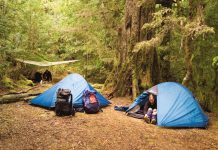Nothing is quite as satisfying as building our own shelter and living in it. Snow caves are so fun and they are enjoyable winter camping events. Set up a large mass of snow, dig it with snow hovels, wrap the bottom and cover the door.

Choosing the right location for snow cave:
- The area should be safe from avalanches.
- Mark the roof of the cave with visible markings.
- Outside of the tent height should be 4-5 feet, according to it choose whether to assemble a pile, tunnel in or dig down.
Piling a snow cave:
- Prepare for 3 hours to build a sufficient snow pile.
- For 2 adults calculate a 10 foot surround. If there are more than 2 adults, then add 2 feet to the diameter for every adult.
- Usage of tarp helps to dig the snow to the pile.
- It is better to pile 2 feet high than the chosen height.
- Allow the pile to assemble for two hours before tunneling into it.
Tunneling out the snow cave:
- Plan for about 3 hours to dig the snow cave
- Wear layers to get rid of insulation. To stay dry and warm, you need to avoid sweating.
- Keep the door small, i.e. about 24-30 inches wide and tall.
- Cut from the top downward.
- Create depth check holes for proper ventilation.









